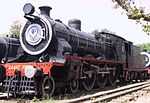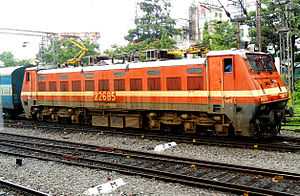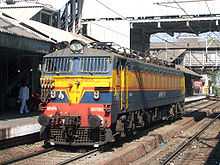Indian locomotive class WAP-7
| WAP-7 | |
|---|---|
|
| |
| Type and origin | |
| Power type | Electric |
| Builder | Chittaranjan Locomotive Works, West Bengal, India |
| Specifications | |
| Gauge | 5 ft 6 in (1,676 mm) |
| Electric system(s) | 25 kV 50 Hz AC AC Overhead |
| Current collection method | pantograph |
| Performance figures | |
| Maximum speed |
Test Run:180 km/h (112 mph) Operational: 140 km/h (87 mph) |
| Power output | 6,350 hp (4,735 kW) |
| Career | |
| Operator(s) | Indian Railways |
| Number(s) | 30201 onwards |
| Locale | Northern Railways, South-Central RailwayEastern Railway South East Central Railway |
WAP 7 is a moderate speed high power locomotive developed by Chittaranjan Locomotive Works by modifying the gear ratio of existing WAG 9 class. It is capable of hauling trains at speeds ranging between 140 and 180 kilometres per hour (87 and 112 mph) and is now largely used by Northern Railways (NR), South Central Railways (SCR), Southern Railways (SR), Eastern Railways (ER), South East Central Railway (SECR), Central Railways (CR), West Central Railways (WCR). As of October 2014, there are 205 locomotives in service.
Similarity with WAG 9
The WAP-7 is actually a modified version of the WAG 9 freight locomotive with modified gear ratios and is set to replace the fleet of WAP 4's, the most widely used passenger locomotive today. The process will be a very slow one however, with WAP 4s still being produced and the production of WAP-7's increasing at a slow pace.
Performance
With a maximum speed rating of 180 km/h (110 mph) (IR restricts it to 140 km/h or 87 mph),[1] the WAP-7 has the highest acceleration figures while hauling mail/express trains. The WAP-7 can also haul loads of 24-26 passenger coaches (1,430–1,550 t or 1,410–1,530 long tons or 1,580–1,710 short tons at 140 km/h or 87 mph).[2] It is also known to haul 18 heavyweight Air Conditioned coaches (1,120 t or 1,100 long tons or 1,230 short tons) on 1:40 (2.5%) inclines single-handedly. At a trial conducted by Indian Railways, it clocked a speed of 184 km/h (114 mph). It is the most successful passenger locomotive on the Indian Railways roster after the WAP-4. It is used to haul premium trains like the Rajdhani Express and the Shatabdi Express apart from other regular mail/express trains.[3] It also regularly hauls other trains like the Hyderabad - New Delhi, H.Nizamuddin-Thiruvananthapuram, H.Nizamuddin-Chennai, H.Nizamuddin-Bangalore, New Delhi-Sealdah and the New Delhi - Mumbai Rajdhani Express and Nizamuddin-Ernakulam Duronto Express.
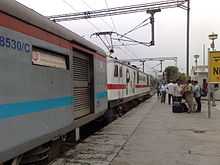
WAP-7 locomotive can deliver 6,000 hp (4,500 kW) with regenerative braking being one of its salient features. The regenerative braking is deployed on down gradients conserving energy to the tune of 30-35 percent. It has an inbuilt microprocessor based fault diagnostic system to make trouble shooting easier.[4] Another feature of this locomotive is that it eliminates the need to have separate EOG sets for air-conditioning in long distance trains hence providing significant amount of savings on maintenance and running costs. This technology, called HOG or "Head On Generation", transfers electric power from the loco's pantograph to the coaches instead of "End on Generation" in which a Power Car equipped with diesel generator capable of generating adequate power of 3-phase 50-cycle 415V/750V AC (called as hotel load) is provided at either end of the train rake to supply power.[5][6][7]
A 24-coach (1500t) passenger rake can be accelerated to 110 km/h in 180 seconds (over 3.7 km) by a WAP-7; to 120 km/h in 235 sec. (5.3 km); 130 km/h in 302 sec. (7.9 km); 140 km/h in 390 sec. (9.1 km); 150 km/h in 490 sec. (11.1 km); and to 160 km/h in 610 sec. (13.1 km).
Technical specifications
| Manufacturers | Chittaranjan Locomotive Works[8] |
| Traction Motors | 6FRA 6068 3-phase squirrel-cage induction motors (850 kW (1,140 hp), 2180 V, 1283/2484 rpm, *270/310A; Weight- 2,100 kg (4,600 lb), forced-air ventilation, axle-hung, nose-suspended; Torque 6,330–7,140 N·m (4,670–5,270 lbf·ft). *95% efficiency.)[8] |
| Gear Ratio | 72:20[8] |
| Axle load | 20.5 t (20.2 long tons; 22.6 short tons)[8] |
| Power | 6,350 hp (4,740 kW)[8] |
| Wheel diameter | 1,092 mm (43 in) new, 1,016 mm (40 in) worn[8] |
| Wheelbase | 15,700 mm (51 ft 6 1⁄8 in)[8] |
| Bogies | Co-Co, Fabricated Flexicoil Mark IV bogies; bogie wheelbase 1,850 mm (72 7⁄8 in) + 1,850 mm (72 7⁄8 in)[8] |
| Unsprung mass per axle | 3.984 t (3.921 long tons; 4.392 short tons)[8] |
| Length over buffers | 20,562 mm (67 ft 5 1⁄2 in)[8] |
| Length over headstocks | 19,280 mm (63 ft 3 in)[8] |
| Body width | 3,152 mm (10 ft 4 1⁄8 in)[8] |
| loco weight | 123 t (121 long tons; 136 short tons)[8] |
| Cab length | 2,434 mm (95 7⁄8 in)[8] |
| Pantograph locked down height | 4,255 mm (13 ft 11 1⁄2 in)[8] |
Locations
The current locomotive sheds which house this locomotive are:
- Ghaziabad (Code:GZB)
- Lallaguda (Code:LGD)
- Ajni (Code:AJNI)
- Howrah (Code:HWH)
- Bhilai (Code:BIA)
- Royapuram (Code:RPM)
- Tughlakabad (Code:Tkd)
Trains hauled by WAP-7
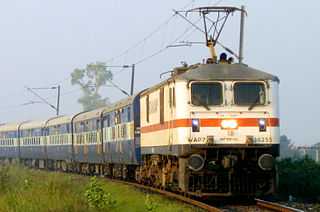
- Sealdah - New Delhi Duronto Express (Howrah WAP-7)
- Howrah Rajdhani Express (Howrah WAP-7)
- Secunderabad Rajdhani Express (Lallaguda WAP-7)
- Secunderabad Hazrat Nizamuddin Duronto Express (Lallaguda WAP-7)
- Hyderabad - New Delhi Andhra Pradesh Express (Lallaguda WAP-7)
- Hyderabad - Hazrat Nizamuddin Dakshin Express (Lallaguda WAP-7)
- Hyderabad - Chennai Charminar Express (Lallaguda WAP-7)
- Secunderabad Visakhapatnam Duronto Express (Lallaguda WAP-7)
- Hyderabad - Visakhapatnam Godavari Express (Lallaguda WAP-7)
- Secunderabad Vishakhapatnam Garib Rath Express (Lallaguda WAP-7)
- Secunderabad - Vijayawada Satavahana SF Express (Lallaguda WAP-7)
- Secunderabad - Kakinada Gowthami SF Express (Lallaguda WAP-7)
- Secunderabad - Sirpur Kaghaznagar Telangana Express (Lallaguda WAP-7)
- Chennai Central - Coimbatore Intercity express (Train 12679 / 12680) (Royapuram WAP-7)
- Chennai Central - Coimbatore Kovai SF express (Train 12675 / 12676) ([[Royapuram railway station] Royapuram] WAP-7)
- Chennai Central - Trivandrum Superfast Mail (12623/12624) (Royapuram WAP 7)
- Durg - Nizamuddin Chhattisgarh Sampark Kranti Express (12823/12824)) (Bhilai/Tughlakabad WAP-7)
- Durg - Bhopal Amarkantak Express (Bhilai WAP-7)
- Nagpur - Bilaspur Intercity Express (Bhilai WAP-7)
- Gondia - Raigarh Jan Shatabdi Express (Bhilai WAP-7)
- Durg - Jammu Tawi Superfast Express (Bhilai WAP-7)
- Chennai Central - Trivandrum Superfast Express (12696/12695) (Royapuram WAP 7)
- Chennai - Alappuzha Express (16041/16042) hauled by (Royapuram WAP 7)
- Chennai Coimbatore Shatabdi Express (Train 12243/12244) (Royapuram WAP-7)
- Nilagiri Express (Train 12672/12671) (Royapuram WAP-7)
- Kerala Sampark Kranti Express (Ghaziabad WAP-7)
- Kochuveli Amritsar S/F Express (Ghaziabad WAP-7)
- Dadar Amritsar Express (Ghaziabad WAP-7)
- Sealdah Rajdhani Express (Ghaziabad WAP-7)
- Chennai Rajdhani Express (Ghaziabad / Lallaguda WAP-7)
- Thiruvananthapuram Rajdhani Express (Ghaziabad WAP-7)
- Bangalore Rajdhani Express (Lallaguda WAP-7)
- Bangalore - New Delhi Karnataka Express (Ghaziabad WAP-7) as of July 2013
- Bilaspur Rajdhani Express (Ajni WAP-7)
- Ranchi Rajdhani Express (Ghaziabad WAP-7)
- Hazrat Nizamuddin - Ernakulam Duronto Express (Ghaziabad WAP-7)
- Hazrat Nizamuddin Pune Duronto Express (Ghaziabad WAP-7)
- Bandra Terminus Hazrat Nizamuddin Yuva Express (Ghaziabad WAP-7)
- Yeshvantapur Delhi Sarai Rohilla AC Duronto Express (Ghaziabad / Lallaguda WAP-7)
- Howrah - New Delhi Yuva Express (Ghaziabad WAP-7)
- Chennai Central Hazrat Nizamuddin Garib Rath Express (Ghaziabad WAP-7)
- Allahabad New Delhi Duronto Express (Ghaziabad WAP-7)
- Himalyan Queen Express (Ghaziabad WAP-7)
- Vijayawada - Visakhapatnam Ratnachal Express (Lallaguda WAP-7)
- Adilabad - Tirupati Krishna Express (Lallaguda WAP-7)
- Tirupati - Hazrat Nizamuddin Andhra Pradesh Sampark Kranti Express (Lallaguda WAP-7)
- Bihar Sampark Kranti Superfast Express (Darbhanga - New Delhi) (Ghaziabad WAP-7)
- Taj Express (Ghaziabad WAP-7)
- Chhattisgarh Express (Ajni WAP-7)
- Amarkantak Express (Ghaziabad WAP-7)
- Sewagram Express (Ajni WAP-7)
- Goa Express (Ghaziabad WAP-7)
- Bhopal Express (Tughlakabad WAP-7)
- Agra - Jhansi Passenger (Ghaziabad WAP-7)
- Chennai Bangalore Mail (Lallaguda WAP-7)
- Chennai Bangalore Express (Lallaguda WAP-7)
- Chennai Bangalore Brindavan Express (Lallaguda WAP-7)
- Bangalore Chennai Shatabdi Express (Lallaguda/Royapuram WAP-7)
- Coalfield Express (Howrah WAP-7)
- Kalka Mail (Howrah WAP-7)
- Howrah - Dhanbad Double Decker Express (Howrah WAP 7)
- Paschim Express (Ghaziabad WAP-7)
- Indore - Hazrat Nizamuddin Intercity Express (Tughlakabad WAP-7)
- Pune Nagpur Garib Rath Express (Ajni WAP-7)
- Pune Nagpur Express (Ajni WAP-7)
- Nagpur Duronto express (Ajni WAP-7)
- New-Delhi Prayag Raj Express (Ghaziabad WAP-7)
- Tirupati-Secunderabad Padmavati Express (Lallaguda WAP-7)
- Howrah New Delhi Poorva Express (Ghaziabad WAP 7)
- Purushottam Express (Ghaziabad WAP 7)
- Kalinga Utkal Express (Tughlakabad WAP 7)
- Chhattisgarh Sampark Kranti Superfast Express
- Grand Trunk Express (12615) hauled by WAP 7 (Royapuram)
- Tamil Nadu Express (12622) hauled by WAP 7 (Royapuram)
- Chennai - Bangalore AC Double Decker Express (22625/22626) (Royapuram/Lallaguda WAP - 7)
- Gorakhpur Lokmanya Tilak Terminus Superfast Express (Ajni WAP-7)
- Patna Rajdhani Express (Ghaziabad/Howrah WAP-7)
- Bangalore City - Bangarapet Express (16521/16522) (Lallaguda WAP-7)
- Manmad Junction - Lokmanya Tilak Terminus Godavari Superfast Express (12118) (Ajni WAP-7)
- Lokmanya Tilak Terminus - Manmad Junction Godavari Superfast Express (12117) (Ajni WAP-7)
- Mumbai Central - New Delhi Rajdhani Express (12951/12953) (Ghaziabad WAP-7)
- Mumbai Central - New Delhi August Kranti Rajdhani Express (12953/12954) (Ghaziabad WAP-7)
- pune hazrat nizamuddin duranto express [GZB wap7]
- Yeshvantpur-Nizamuddin KSK SF Express (Lallaguda WAP-7)
- Chattisgarh Express (Nagpur-H.Nizamuddin) (Ajni WAP-7)
Pooja Express New delhi to Jammu Tawi with WAP 7
Accidents and incidents
On 10 July 2011 Kalka Mail derailed on the Kanpur-Fatehpur line near the Fatehpur railway station , more than 69 persons died and 200 were injured,some critically. The train was hauled by Ghaziabad-based WAP 7 30221. Malfunction of the undergear of the locomotive could also be a reason. The driver of the Kalka Mail said he saw the engine shaking.[9] A post-accident diagnostic revealed that the first axle (leading) of the locomotive registered a jerk and the fourth axle (trailing bogie) showed loss of contact of the wheel with the track. The locomotive in question has been re-railed and is undergoing fault diagnostics and repairs.
On 14 December 2014 the 12381 UP Howrah - New Delhi Poorva Express derailed at 8.27 am after leaving Howrah at 8.15 am. 11 sleeper coaches and a pantry car (AC Hot Buffer Car) of the New Delhi-bound Poorva Express derailed at Liluah shortly after leaving Howrah station. There was no casualty or injury to any passenger. Like Kalka Mail this train was also hauled by Ghaziabad-based WAP 7. But the locomotive did not face much damage hence after undergoing fault diagnostics and repairs the locomotive has been re-railed.
See also
References
- ↑ PTI. "New energy-efficient loco introduced for high speed trains". Economic Times. Retrieved Feb 9, 2012.
- ↑ (PDF) http://www.rdso.indianrailways.gov.in/works/uploads/File/13_10_09.pdf. Missing or empty
|title=(help) - ↑ "New energy-efficient loco introduced for high speed train". Economic Times. 9 Feb 2012. Retrieved 25 Aug 2012.
- ↑ "Southern Railway inducts fast locomotive". The Hindu. 18 Oct 2012.
- ↑ "Train had WAP-7 engine, ‘black box’ may reveal cause". Zee News. 9 Aug 2010. Retrieved 25 Aug 2012.
- ↑ "Recent Developments". Chittaranjan Loco works. Retrieved 25 Aug 2012.
- ↑ "Development of Electric locomotive with Head On Generation (HOG) facility" (PDF). Indian Railways.
- ↑ 8.0 8.1 8.2 8.3 8.4 8.5 8.6 8.7 8.8 8.9 8.10 8.11 8.12 8.13 8.14 "Recent Developments". IRFCA.
- ↑ "Engine failure behind Kalka Mail tragedy". IBN Live. 13 July 2011. Retrieved 14 July 2011.
External links
| Wikimedia Commons has media related to Indian locomotive class WAP7. |
- IRFCA-Indian Railways Fan Club
- CLW Railways India
- Notes on electric locos from IRFCA-Indian Railways Fan Club
- IR WAP-7 @ Trainspo
| ||||||||||||||||||||||||||||||||||||||||||||||||||||||||||||||||||||||||||||||
